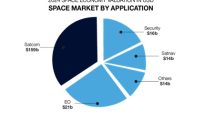 The satellite industry is in a period of fantastic innovation, with new developments and technology appearing continually. As the industry develops, there is no doubt that these trends will have a significant impact on interference. It is as yet unclear whether this will overall be for the better.
The satellite industry is in a period of fantastic innovation, with new developments and technology appearing continually. As the industry develops, there is no doubt that these trends will have a significant impact on interference. It is as yet unclear whether this will overall be for the better.
VSAT moving to higher frequency bands
We are already seeing the benefits of high frequency bands, giving users much more bandwidth at a lower cost than ever before. It is not surprising, therefore, that more and more VSAT users are moving to higher frequency bands. That could be moving from C-band to Ku-band or from Ku-band to Ka-band. We are witnessing less and less traffic on C-band year on year, and that trend is likely to continue, with C-band traffic reduced to a minimum in a few years’ time.
With the move to higher frequency, we have moved from circular polarisation to linear, and now we are back at circular polarisation. On the downside, this is associated with poorer cross-pol performance. However, you do away with the need to adjust polarisation manually, getting rid of the all too prevalent risk of human error.
HTS for data services
The other trend I expect over coming years is High Throughput Satellite being used for a large proportion of data services. These systems bring a number of advantages when it comes to interference prevention and resolution. Intentional interference will be extremely unlikely, as any would-be interferer would have to land precisely in gateway beam. Also, smaller spot beams make it easier to get a rough idea of the location of any interference extremely quickly. It is also easier to geolocate, resulting in a more precise location, even with just one satellite.
With data services using HTS, we will also see an increasing trend for teleport owners to also be satellite owners. This will mean owners having an interest in keeping the teleport infrastructure in good shape, so less likely to cause interference.
Shift from SCPC to TDMA
This is of course nothing new, but it will certainly continue at a fast pace. This brings a number of challenges, as it is inherently burst-mode in nature, which means tracking down specific interferers is extremely challenging. New tools such as SatGuard from VeriSat will be vital in locating those instances quickly and efficiently.
Mobility
Satellite is increasingly being used on the go, with the mobility market a key customer for many satellite operators. When dealing with mobile users, there is an extra layer of difficulty for satellite operators. You are much more likely to get intermittent issues, which again are much harder to locate.
Antennas getting smaller…and flatter
Ka-band has brought many benefits; however, as antennas get smaller and smaller, those benefits are becoming negated. We are also seeing huge investment in the development of flat panels, and in the not so distant future we are likely to start to see electronically steered flat panel antennas released onto the market. The challenges that will likely come from this are as yet unknown, but they may also bring many benefits. Exactly how that will play out remains to be seen.
Innovation breeds mitigation
While many of these trends present challenges for interference mitigation, the vast majority will do their bit to reduce instances or help us resolve it quickly. Coupled with some really rather exceptional solutions we have seen emerge over recent months, it feels like we may be winning the war against interference. The biggest challenge will now be getting all satellite operators and users to see the benefits of proper interference management and adopt these tools.














Add Comment